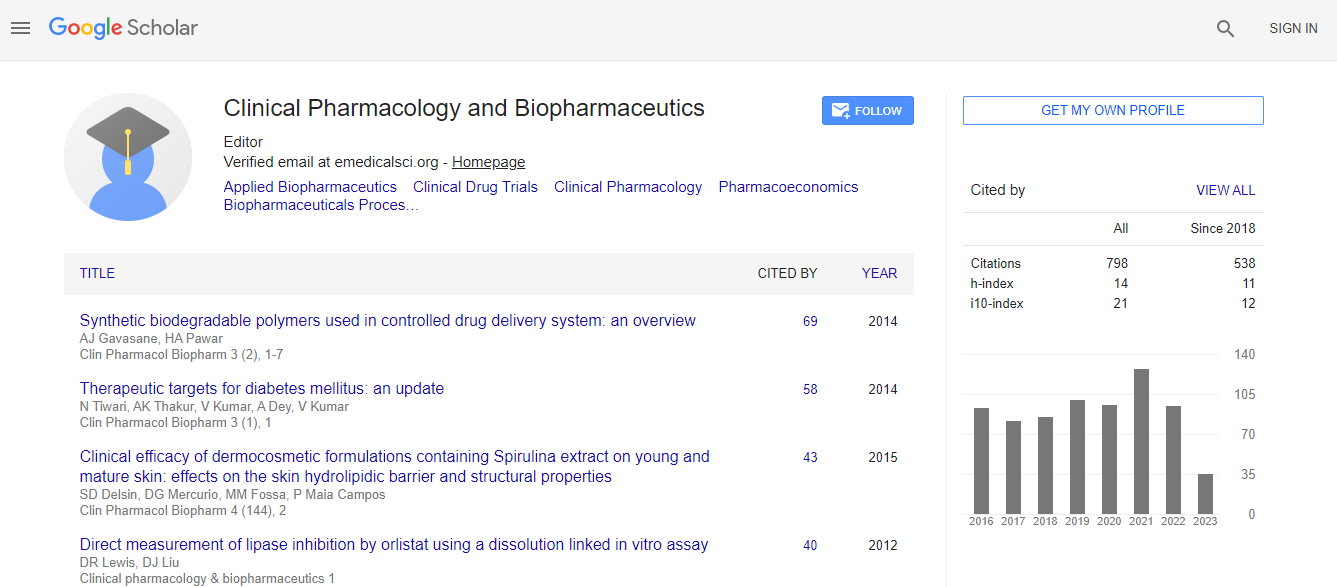Our Group organises 3000+ Global Conferenceseries Events every year across USA, Europe & Asia with support from 1000 more scientific Societies and Publishes 700+ Open Access Journals which contains over 50000 eminent personalities, reputed scientists as editorial board members.
Open Access Journals gaining more Readers and Citations
700 Journals and 15,000,000 Readers Each Journal is getting 25,000+ Readers
Google Scholar citation report
Citations : 1089
Clinical Pharmacology & Biopharmaceutics received 1089 citations as per Google Scholar report
Clinical Pharmacology & Biopharmaceutics peer review process verified at publons
Indexed In
- CAS Source Index (CASSI)
- Index Copernicus
- Google Scholar
- Sherpa Romeo
- Genamics JournalSeek
- RefSeek
- Hamdard University
- EBSCO A-Z
- OCLC- WorldCat
- Publons
- Euro Pub
- ICMJE
Useful Links
Recommended Journals
Related Subjects
Share This Page
Self-assembling of bioactive agents √¢¬?¬? A way to generate new drugs. The case of mesalamine: sucralfate complexes
International Conference and Expo on Biopharmaceutics
Pompilia Ispas-Szabo and Mircea Alexandru Mateescu
Universit√?¬© du Qu√?¬©bec √?¬Ý Montr√?¬©al, Canada.
ScientificTracks Abstracts: Clin Pharmacol Biopharm
Abstract
Macromolecular self-assembly represents an interesting way to produce materials for various therapeutic applications (targeted drug delivery, bioactive encapsulation). Considerable interest relates to the design of polymer- or peptide-based self-assembled biomaterials due to the possibility to generate different specific properties by new arrangements at molecular level. Differently from existing approaches which explore mainly the drug-excipient association in order to improve solubility, we are proposing a new alternative √¢¬?¬? the drug-drug self-assembling, using two different active molecules. Mesalamine (5-aminosalicylic acid, MES) is an efficacious active ingredient used for the long-term therapy of inflammatory bowel disease. However, its oral administration is frequently associated with systemic side effects caused by drug absorption in the upper gastrointestinal tract. Sucralfate (SUC) is a non-systemic site protector prescribed in the treatment of inflammation and gastric ulceration. The anti-inflammatory action of MES in association with bioadhesiveness and mucosal healing properties of SUC were considered promising for the development of a new compound containing both molecules, aimed as an improved treatment of ulcerative colitis. The present case investigated the capacity of the two active agents to interact and generate a new and stable entity via self-assembling. Spray-drying was used to co-process the two active principles from an aqueous mixture. Preliminary in vitro studies with oral solid dosage forms based on the obtained MES-SUC complexes have shown a controlled MES release, opening the perspective of a new colon-targeted delivery system and a novel class of compounds with therapeutic application in inflammatory bowel diseases.Biography
Pompilia Ispas-Szabo is Adjunct Professor at Université du Québec à Montreal (UQAM, Canada) and a Research & Development scientist in pharmaceutical industry. She completed her MSc in Physical Chemistry at Bucharest University and the PhD at UQAM. Co-inventor of new excipients proposed as matrices for controlled drug delivery or new products, she worked in various Canadian pharmaceutical companies (Smartrix Technologies, IntelGenx Corp., Aptalis Pharma, etc.), being involved in the development of innovative products or technological platforms. Co-author of 10 patents/applications, more than 30 papers in reputed journals, one book, two bookchapters, member of Controlled Release Society and AAPS, and reviewer for several international journals, she is recognized for her contribution to academic and industrial innovation.
Email: pompilia_08@yahoo.ca

 Spanish
Spanish  Chinese
Chinese  Russian
Russian  German
German  French
French  Japanese
Japanese  Portuguese
Portuguese  Hindi
Hindi 
